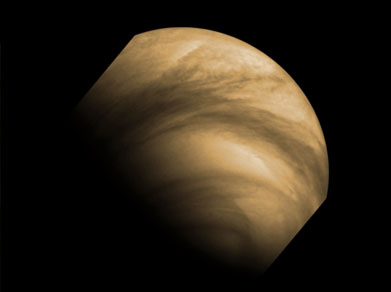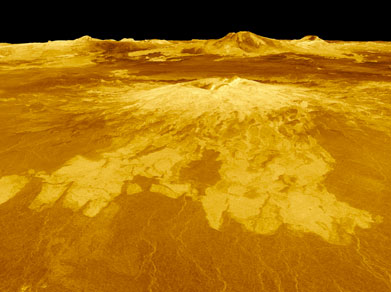
Second planet from the Sun and our closest planetary neighbor, Venus is similar in structure and size to Earth, but it is now a very different world. Venus spins slowly in the opposite direction most planets do. Its thick atmosphere traps heat in a runaway greenhouse effect, making it the hottest planet in our solar system—with surface temperatures hot enough to melt lead. Glimpses below the clouds reveal volcanoes and deformed mountains.
If the sun were as tall as a typical front door, the Earth and Venus would each be about the size of a nickel.
Venus orbits our Sun, a star. Venus is the second closest planet to the sun at a distance of about 67 million miles (108 million km).
One day on Venus lasts 243 Earth days because Venus spins backwards, with its sun rising in the west and setting in the east.
Venus' solid surface is a volcanic landscape covered with extensive plains featuring high volcanic mountains and vast ridged plateaus.

Venus' solid surface is a volcanic landscape covered with extensive plains featuring high volcanic mountains and vast ridged plateaus.
Venus has no moons and no rings.
The planet’s surface temperature is about 900 degrees Fahrenheit (465 degrees Celsius)—hot enough to melt lead.
The planet’s surface temperature is about 900 degrees Fahrenheit (465 degrees Celsius)—hot enough to melt lead.
Many scientists believe water once existed on the surface. Future Venus explorers will search for evidence of an ancient ocean.
More than 40 spacecraft have explored Venus. The ‘90s Magellan mission mapped the planet's surface and Akatsuki is currently orbiting Venus.
Venus’ extreme temperatures and acidic clouds make it an unlikely place for life as we know it.
While the surface rotates slowly, the winds blow at hurricane force, sending clouds completely around the planet every five days.

The Soviet Union’s Venera 13 survived the intense heat and crushing pressure of Venus’ surface for more than two hours. Engineers from several nations are currently studying methods to extend the life of robotic spacecraft in the extreme environment.
Named after the goddess of love and beauty, Venus has become nearly synonymous with "woman" in popular culture, as referenced by the famous relationship guide Men are from Mars, Women are from Venus. As a solar system locale, Venus was a popular destination for early 20th century science fiction writers; before we knew about what lay beneath Venus' mysterious cloud cover, writers could speculate about a more hospitable planet and its possible inhabitants.
More recently, Venus has been a backdrop for video games such as Transhuman Space, Battlezone and Destiny. And in the Disney animated film The Princess and the Frog, Ray the firefly falls in love with Venus, "the evening star," as he has mistaken it for another firefly.
Page Updated: October 7, 2019